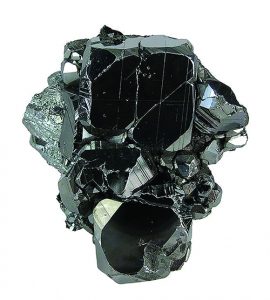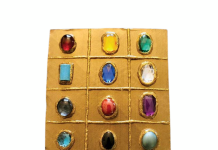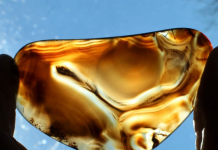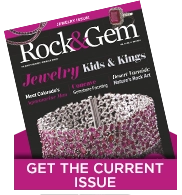
By Steve Voynick
Mineral collectors are familiar with the silvery-black color and submetallic luster of the crystalline and botryoidal forms of hematite. But most hematite is not black at all. It’s red, and there is a lot of it—enough, in fact, to color Georgia’s red dirt, Utah’s red-rock canyons, Minnesota’s vast deposits of red iron ore, and even the barren, red landscape of the planet Mars.
Hematite, or iron oxide (Fe2O3), is the primary ore of iron and one of the most abundant minerals in the earth’s crust. With a substantial Mohs hardness of 5.5-6.5 and a relatively high specific gravity of 4.9-5.3, hematite crystallizes in the trigonal system as tabular crystals, rosette-like aggregates, and botryoidal structures. But most of the hematite in existence is not crystalline; instead, it occurs as tiny particles in massive, earthy and granular forms.
Hematite’s Inconsistent Coloring
Especially interesting is hematite’s color, which can be red or silvery-black. This seeming inconsistency initially confused early scientists in their attempts to recognize the various forms of hematite as a singular mineral species. Only in the late 1700s did they understand that hematite occurred in both red and black forms, but another century passed before they could explain exactly why hematite exhibited two radically different colors.

Any mineral’s color is determined by the manner in which it absorbs and reflects light, which varies with chemistry and the nature of its crystal structure. But mineral color is classified into two categories: streak color and apparent color.
Streak color, also called “powder color” or “true color”, refers to the color of a mineral in powdered form. Powdered minerals consist not of intact crystals, but of tiny, randomly oriented, irregularly shaped particles. To determine streak color, minerals are ground to a powder or, more conveniently, rubbed across a tile of unglazed, white porcelain (called a streak plate) to produce lines, or streaks, of color.
Because streak color is very consistent, it is a valuable mineral-identification feature.
Apparent color, on the other hand, refers to the color of macrocrystalline minerals, which would include most of the specimens in our collections. Unlike streak color, apparent color can vary considerably among individual specimens of the same species.
Color and Streak Congruency
A mineral’s color is said to be congruent when its apparent color generally matches its streak color; when they are different, the mineral’s color is incongruent.
An example of a mineral with congruent colors is azurite, because both the apparent color and streak color of an azurite crystal are blue.
Examples of minerals with incongruent colors are pyrite and chalcopyrite; both have brassy-yellow apparent colors, but greenish-black streaks. Another is rhodochrosite; even the most intensely red crystals leave a white streak.
Hematite is unusual in that its macrocrystalline forms are incongruent, while its particulate forms are congruent. The apparent color of macrocrystalline and botryoidal hematite is determined by its smooth crystal faces, which absorb all wavelengths of white light more or less equally to reflect a neutral, silvery-black color.
But particulate hematite, which has neither crystal faces nor cleavage planes, is red. Whether natural or powdered on a streak plate, the surfaces of hematite particles are rough and irregular. Together, millions of these particles absorb the blue, green and yellow wavelengths of white light, while reflecting only the red wavelengths.
Crystalline hematite, with its smooth, lustrous, silvery-black tabular crystals and botryoidal forms will always catch the eyes of mineral collectors. But red, particulate hematite, which occurs mostly in massive or granular forms, is not found in many collections. Among its few collectible forms are polished specimens of the distinctively banded, red iron ores of Minnesota’s Mesabi Range. Although it is not widely collected, particulate hematite is the greatest of all mineral coloring agents, lending its distinctive red coloration to everything from the dirt and rocks of Georgia, Utah and Minnesota all the way to the planet Mars.
Author: Steve Voynick
 A science writer, mineral collector, and former hard rock miner, he is also the author of many references including, “Colorado Rock Hounding” and “New Mexico Rockhounding.”
A science writer, mineral collector, and former hard rock miner, he is also the author of many references including, “Colorado Rock Hounding” and “New Mexico Rockhounding.”
Learn more about Mr. Voynick from his site: Mountain Press Publishing.














